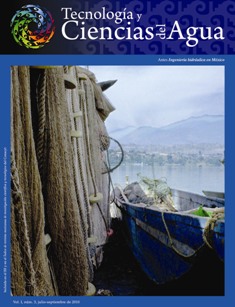Discussion of the article “A simple and useful modification of the index avenue method”
DOI:
https://doi.org/10.24850/j-tyca-2010-03-08Keywords:
discussion, regional homogeneityAbstract
The authors (Ramírez and Arellano-Lara, 2010) have presented the original theoretical version of the test that allows verification of regional homogeneity for floods or maximum floods, known as the Langbein test. In addition, they make a correction or modification to the original application procedure to avoid taking into account hydrometric stations with large deviations. In view of this situation, the polemicist considers it convenient to make it known that deficiencies have been found in the original theory of the test and that its application procedure has been modified to allow for the presence of stations with large dispersion within the region, which will still be homogeneous. In addition, the test is no longer applied with a common period of data, which makes it more versatile and convenient, since it is not necessary to deduce missing values.
References
CAMPOS, D.F. Aplicación del método de índice de crecientes en la Región Hidrológica Número 10, Sinaloa. Ingeniería hidráulica en México. Vol. IX, núm. 3, septiembre-diciembre de 1994, pp. 41-55.
CAMPOS, D.F. Contraste de métodos regionales de estimación de crecientes en la cuenca del río Guayalejo, en Tamaulipas. Tláloc. Núm. 37, mayo-agosto de 2006, pp. 14-24.
CHOW, V.T. Frequency Analysis. Section 8-I. Handbook of Applied Hydrology. Ven Te Chow (editor in chief). New York: McGraw-Hill Book Co., 1964, pp. 8.1-8.42.
DALRYMPLE, T. Flood-Frequency Analyses. Manual of Hydrology. Part 3: Flood-Flow Techniques. Washington, D.C.: U.S. Geological Survey, Water-Supply Paper 1543-A, 1960.
FILL, H.D. and STEDINGER, J.R. Homogeneity test based upon Gumbel distribution and a critical appraisal of Dalrymple's test. Journal of Hydrology. Vol. 166, 1995, pp. 81-105. DOI: 10.1016/0022-1694(94)02599-7
GUTIÉRREZ, A. y RAMÍREZ, A.I. Predicción hidrológica mediante el método de la avenida índice para dos poblaciones. Ingeniería hidráulica en México. Vol. XX, núm. 2, abril-junio de 2005, pp. 37-47.
KITE, G.W. Regional Analysis. Chapter 13. Frequency and Risk Analyses in Hydrology. Fort Collins: Water Resources Publications, 1977, pp. 169-199.
LU, L.H. Statistical methods for regional flood frequency investigations. Ph.D. Dissertation. Ithaca, USA: Cornell University, 1991, 236 pp.
PONCE, V.M. Regional Analysis. Chapter 7. Engineering Hydrology. Principles and Practices. Englewood Cliffs, USA: Prentice Hall, Inc., 1989, pp. 233-251.
RAMÍREZ, A.I. y ARELLANO-LARA, F. del R. Una modificación simple y útil del método de la avenida índice. Tecnología y Ciencias del Agua, antes Ingeniería hidráulica en México. Vol. I, núm. 1, enero-marzo de 2010, pp. 69-85. DOI: 10.24850/j-tyca-2010-01-06
SINGH, V.P. Regional Frequency Analysis. Theme 25.4. Elementary Hydrology. Englewood, USA: Prentice Hall, 1992, pp. 824-839.
WILTSHIRE, S.E. Regional flood frequency analysis I: Homogeneity statistics. Hydrological Sciences Journal. Vol. 31, 1986, pp. 321-333. DOI: 10.1080/02626668609491051
Downloads
Published
How to Cite
Issue
Section
License
Copyright (c) 2010 Tecnología y ciencias del agua

This work is licensed under a Creative Commons Attribution-NonCommercial-ShareAlike 4.0 International License.
By Instituto Mexicano de Tecnología del Agua is distributed under a Creative Commons Attribution-NonCommercial-ShareAlike 4.0 International License. Based on a work at https://www.revistatyca.org.mx/. Permissions beyond what is covered by this license can be found in Editorial Policy.









